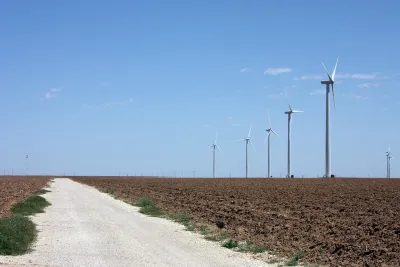If coal use phases out in Texas, renewable energy could very likely pick up the slack.

A study from Rice University says that wind and solar production in the state is complementary and could take the place of coal energy, which now makes up a quarter of the state’s power, reports Erin Douglas:
Scientists found that between wind energy from West Texas and the Gulf Coast, and solar energy across the state, Texas could meet a significant portion of its electricity demand from renewable power without extensive battery storage. The reason: These sources generate power at different times of day, meaning that coordinating them could replace production from coal-fired plants.
However, Douglas notes that weather is unpredictable. "Texas would still need battery storage and natural gas-fired power plants to fill in gaps when, for example, winds might slacken earlier than expected."
Wind power makes up 18 percent of Texas’ electricity, and the state produces the most wind energy in the country. Solar power has yet to ramp up substantially, and it currently only contributes to 1 percent of the state’s power. However, because Texas has a great deal of sunshine and the cost of solar continues to drop, energy experts predict it will play a bigger role in the future.
FULL STORY: Texas has enough sun and wind to quit coal, Rice researchers say

National Parks Layoffs Will Cause Communities to Lose Billions
Thousands of essential park workers were laid off this week, just before the busy spring break season.

Retro-silient?: America’s First “Eco-burb,” The Woodlands Turns 50
A master-planned community north of Houston offers lessons on green infrastructure and resilient design, but falls short of its founder’s lofty affordability and walkability goals.

Delivering for America Plan Will Downgrade Mail Service in at Least 49.5 Percent of Zip Codes
Republican and Democrat lawmakers criticize the plan for its disproportionate negative impact on rural communities.

Test News Post 1
This is a summary

Test News Headline 46
Test for the image on the front page.

Balancing Bombs and Butterflies: How the National Guard Protects a Rare Species
The National Guard at Fort Indiantown Gap uses GIS technology and land management strategies to balance military training with conservation efforts, ensuring the survival of the rare eastern regal fritillary butterfly.
Urban Design for Planners 1: Software Tools
This six-course series explores essential urban design concepts using open source software and equips planners with the tools they need to participate fully in the urban design process.
Planning for Universal Design
Learn the tools for implementing Universal Design in planning regulations.
EMC Planning Group, Inc.
Planetizen
Planetizen
Mpact (formerly Rail~Volution)
Great Falls Development Authority, Inc.
HUDs Office of Policy Development and Research
NYU Wagner Graduate School of Public Service





























